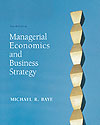This chapter presents pricing strategies used by firms
with some market power. Unlike firms in a perfectly competitive market, when
a small number of firms or products are slightly differentiated, a manager can
use pricing strategies that will foster positive economic profits. These strategies
range from simple markup rules to more complex two-part pricing strategies that
enable a firm to extract all consumer surplus. This chapter shows how markup rules come into existence.
If a firm is monopolistic or monopolistically competitive, a simple pricing
rule can be found using the elasticity from the firm's demand function. By dividing
the own-price elasticity of demand by one plus the own price elasticity of demand,
a manager can find the markup factor that will maximize the firm's profits.
If a manager operates in a Cournot oligopoly, the firm's own-price elasticity
is simply the number of firms in the market times the market elasticity. Knowing
this, a manager in this kind of market can easily calculate the appropriate
markup rule for his or her pricing strategies. In some markets, the manager can actually do better than
the single monopoly price. This can be accomplished through price discrimination
if there are two or more distinctly different types of consumers. Other pricing
strategies that enhance profits include peak-load pricing, block pricing, transfer
pricing, commodity bundling, and cross-subsidization. The chapter concludes
with descriptions of strategies that can help managers in a Bertrand oligopoly
avoid the tendency toward zero economic profits. |




 2002 McGraw-Hill Higher Education
2002 McGraw-Hill Higher Education